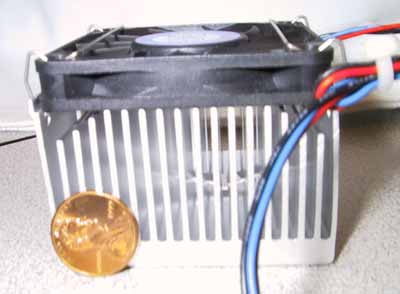AMD Athlon "Thunderbird" 1.2GHz & Duron 800MHz
by Anand Lal Shimpi on October 17, 2000 12:56 AM EST- Posted in
- CPUs
Cooling the Chip
As the original K7 Athlons ramped up in speed AMD ran into two issues with bringing them to market:
1) They started to draw incredible amounts of current and produce quite a bit of heat, the Athlon (K7) 650 dissipated up to 54W of heat. This was more then the first 0.35-micron Pentium IIs.
2) Finding high speed L2 cache chips that could operate at 1/2 the core frequency became increasingly difficult as the Athlon hit 700MHz.
AMD’s solution there was the K75, which remedied the first issue by moving to a cooler 0.18-micron process and took care of the second by decreasing the L2 cache multiplier so that the L2 cache only ran at 2/5 of the CPU clock.
As the K75 began to ramp up in speed, the L2 cache frequency began to drop as AMD eventually went to a 1/3 divider. This brought up another issue, the diminishing returns on performance with every increase in clock speed as the L2 cache was still hovering in the 300 – 350MHz range.
AMD once again remedied this situation with the introduction of the Thunderbird core, which integrated the cache onto the processor’s die running at full speed. However the Thunderbird that has carried us for the past four months is running into a problem of its own, heat.
The 1.1GHz Athlon that was released just under two months ago has already surpassed the first 0.25-micron in terms of heat dissipation as well as power being drawn. And as you can guess, the 1.2GHz produces even more heat and draws even more power.
The 1.2GHz Athlon was cooled using the same Tai Sol heatsink/fan combo we used on the 1.1GHz processor. This particular heatsink places quite a bit of pressure on the CPU itself and does demand a decent amount of effort to mount because of the little room for tolerance in the heatsink clamp.
The Duron is still operating within a very reasonable limit, since it is quite a ways behind the Athlon in terms of operating frequency. However when the Duron does hit the 1.2GHz and beyond speeds of the current Athlon it will most definitely run into the same issues of being one hot little chip.
If history repeats itself, which it most definitely will, expect to see a new, low power, revision of the Athlon core from AMD; and since the Duron is very closely based upon the Athlon, you can expect to see this translated down to the Duron line as well. Necessity has proven itself to be the mother of invention time and time again, and if AMD continues their string of success expect this to hold true yet again.












0 Comments
View All Comments